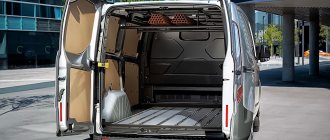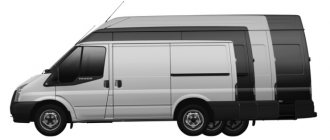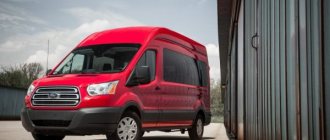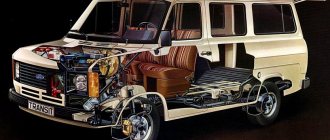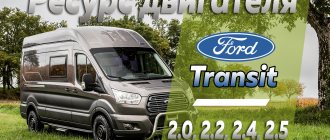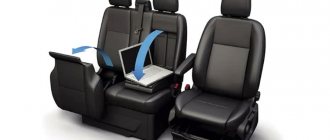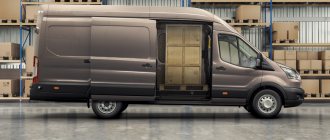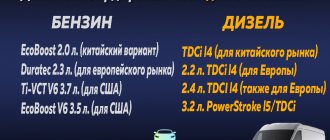Competitions between car companies regarding their cars only benefit consumers. Each company tries to interest the buyer in its model by providing better equipment, comfort and functionality. Moreover, such competitions apply not only to passenger cars, but also to commercial vehicles.
The result of proving the superiority of its model was the emergence of a new, now seventh generation, Ford Transit van. Additionally, the company decided to launch a separate version of the light-duty van, called Ford Transit Custom.
The new Ford Transit Custom was released in 2012, but it took a long time to reach us; we started selling it at the beginning of 2014. So we can assume that for us it is the 2014 Ford Transit Custom. Moreover, after release, no design changes were made to this model.
Versions, dimensions, appearance of Ford Transit Custom
The Ford Transit Custom is available in three versions: Van cargo van, Double Cab-in-Van cargo-passenger version, and Combi passenger version. Moreover, this commercial vehicle is also offered with two bodies of different lengths - L1 and L2. But for now only the Van version is supplied to us, and only with body length L1.
The main overall dimensions and load capacity indicators of the Van model are shown in the table:
| Characteristics and performance of Ford Transit Custom L1 | ||
| Parameter | Unit change | Index |
| Length | mm | 4972 |
| Width | mm | 2290 |
| Height | mm | 2020 |
| Wheelbase | mm | 2933 |
| Cargo volume. compartment | cube m. | 5,36/5,95 |
| Load length compartment | mm | 3085 |
| Cargo width compartment | mm | 1175 |
| Load capacity | kg | 683-1414 |
Chassis Ford Transit 460 EF D/C
Equipment light tinting of windows electric windows central locking with remote control ESP with ABS (anti-lock brake system)
Interior lockable compartments on the driver's and passenger's sides 12-volt socket on the driver's side console compartment for A4 documents or a writing tablet at the top of the console storage compartment on the passenger's side parking ticket holder folding table with two cup holders glove box two bottle holders 2 liter capacity side pocket in the driver's door heater with air recirculation mode
Geometric dimensions of the Ford Transit 460 EF D/C chassis
A - length without step - 6319 mm B - width (with/without) - 2492/1974 C - height - 2015-2030 mm D - distance from the center of the front wheel to the front bumper - 933 mm E - wheelbase - 3954 mm F - distance from the center of the rear wheel to the rear edge of the frame - 1427 N - length of the loading platform - 3162 mm O - height from the ground to the frame - 652 - 657 mm Q - distance from the rear wall of the cabin to the center of the front wheel - 2223 mm R - distance from the rear cabin walls to the center of the rear wheel - 1731 mm
Load capacity and maximum permissible loads
Payload - 2558 kg Load capacity - 2633 kg Gross permissible weight - 4600 kg Curb weight - 1967 kg Final drive ratio - 3.91 Gross permissible train weight - 6500 kg
Engine 2.2 liter turbodiesel Duratorg TDCi with a power of 114 kW and 155 hp. With. Working volume - 2198 cm3. 4 cylinders in line/Double camshafts, 16 valves - 4 per cylinder Light alloy cylinder head Multi-point fuel injection Common-Rail fuel rail Turbocharging with intercooler Variable geometry turbine EGR system - Exhaust Gas Recirculation System Power - 114 kW 155 hp With. at 3500 min-1 Maximum torque - 385 Nm at 1600 min-1
Wheels Wheels - 5×16" steel, hub cap, tires 215/75 R16C
Design features The brake system is dual-circuit with a booster and self-regulation. The brake mechanisms of the front and rear wheels are disc. ABS - standard equipment Fuel tank capacity - 80 liters Steering - power steering Suspension - Front - independent MacPherson type with coil springs of variable stiffness, gas-filled shock absorbers and anti-roll bar. Rear - with leaf springs and gas-filled shock absorbers Transmission - 6-speed manual gearbox
Cabin and cargo area of Ford Transit Custom
The designers did a good job of designing both the cabin and the cargo compartment. The cabin of the Van version is designed for three people, and it is separated from the cargo compartment by a partition. In other versions there is no partition.
The front panel is quite well made. The analog-digital instrument panel has a clear distinction between information sensors. There is an additional lockable box on the panel above the dashboard.
The center console at the top is equipped with an audio system display. The controls for this system are installed below, and the keys themselves are quite large and have a harmonious arrangement.
The bottom of the center console is reserved for the gearshift lever and climate system knobs.
For small items in the cabin there is a fairly voluminous panel glove compartment. Also, some things can be placed under the passenger seats.
Convenience of the driver's position is ensured by 8-channel seat adjustment and 2-range steering column adjustment.
The cargo compartment is equipped with all kinds of hooks and fasteners for cargo. Moreover, they are installed on the sides and can move; this decision of the designers provided the compartment with a flat floor.
Test drive Ford Transit Van: 2000 km express marathon
The job of a truck driver is hard work. Thousands of kilometers of a monotonous route, long hours in one sitting position, the eternal struggle with fatigue and sleep - these are not all the “charms” and not the romantic images that are sung in Soviet and Russian songs about this profession. That is why the cabins of some tractors are practically a one-room apartment. And the car, in general, turns into not just a means of transportation, but a real friend with whom the truck driver spends most of his life.
Could a noticeably smaller car, but with the same tasks, become such a friend? For example, a Ford Transit delivery van?
I'm sure everyone has seen this car. Many, even those who do not have a driver's license, drove it. Countless numbers of these commercial “transits” scurry around the city in the form of vans, flatbed trucks, minibuses and even ambulances. But our task is different - long-distance. Although, we will still have to travel a certain part of the way through the city.
For testing we got a Ford Transit in the 125T350 modification with an average wheelbase length and an average roof height in a front-wheel drive version. The digital encryption of the name means that a 125-horsepower turbodiesel is working under the hood, and the total curb weight does not exceed 3.5 tons - an ordinary “passenger” license of category “B” will do. True, once you are in the car cabin, you understand that Transit is still a little closer to trucks. The mention of the drive type is no coincidence. The fact is that the Ford Transit is a unique commercial vehicle that can be chosen with any (!) type of drive: front-wheel drive, rear-wheel drive or all-wheel drive. The high seating position opens up a 180-degree panoramic view, but the lack of an interior rear-view mirror will take some getting used to. Fortunately, the side two-tier “burdocks” make it quite easy to determine what is going on behind. The overall design of the interior, which is pleasant to look at but not to the touch, also smacks of some gigantism: on the monumental center console, which occupies most of the panel, there is a double-din radio, the buttons of which can be pressed even with gloves or mittens, and three heater control knobs. A convenient “joystick” for the six-speed manual transmission is also located here. The abundance of cup holders, pockets and glove compartments is also pleasing - there are more than a dozen of them on the front panel alone (!).
Getting comfortable behind the wheel will not be a big problem - the driver's seat has a full range of necessary adjustments and armrests. But the uncomfortable two-seater “bench” with a vertical back is screwed tightly. A trip of three, especially over a long distance, will be torture for passengers. But it was not without ergonomic shortcomings. The steering column, for example, is not adjustable at all - having adjusted the seat to suit me, I really wanted to pull the steering wheel towards me so as not to drive with my arms outstretched. For some reason, Ford placed the steering column switch that controls the “music” on the left, noticeably moving the turn signal lever. The lids of both upper glove compartments do not lock in the open position, and there is no folding table with a paper holder, which is standard equipment on French and German competitors. All these, of course, are little things that you can get used to, because the main amenities of the Transit should be in the cargo compartment, and not in the passenger compartment. Several kilometers around the city to the construction base, where I had to load up, caused extremely pleasant impressions, first of all, from the dynamics. Accustomed to naturally aspirated gasoline cars waking up at three to four thousand rpm, I never expected that a Ford Transit cargo truck with the aerodynamics of a brick would leave most of the city traffic behind. The reason is the impressive torque of the 2.2-liter turbodiesel of 330 Newton meters, available from 1500 rpm. The main thing is to have time to catch “short” passes in time.
But the performance of the brakes was surprising, and to put it bluntly, disappointing. Either the drivers of the dealership had already tired the braking system over ten thousand kilometers of the test car, or it was initially configured this way, but against the backdrop of the agility of the Ford Transit, which instantly responds to the accelerator, pressing the brake pedal halfway had virtually no effect on deceleration. Only when it reached the floor did the central pedal force the nearly two-ton Ford to slow down. Such a “feature” in the cramped and nervous city traffic often frightened me. But driving a large cargo van is no more difficult than driving a car. You quickly get used to the dimensions of the Ford Transit thanks to the same panoramic view. Just don’t forget about the more than five-meter length of the car - you have to drive into 90-degree turns at a larger radius so as not to hit your neighbors downstream or hit the curb with the rear wheel. Of course, in tight parking conditions, some skills, habit and accuracy will be required. But I was lucky; there was enough free space at the construction site to drive up to the loading zone without any problems. The cargo compartment of the test vehicle is average in all respects: platform length – 2950 mm, height from floor to ceiling – 1745 mm. Volume - about 8 cubic meters. Load capacity – 1600 kg. Factory cladding with chipboard and wooden crossbars is an option. But all Ford Transit Vans have a partition.
The compartment had to be completely filled: a whole pallet of 2.7-meter lining and half a ton of cement. But, as it turned out, there were no problems with loading. A forklift leaving the warehouse simply placed a wooden pallet on the floor. Twenty bags of cement were also located nearby. However, despite the fact that the length of the platform exceeded the length of the loaded lining by as much as 25 cm, the boards fit snugly. The reason for this is the partition that is convex above the middle into the cargo compartment. You need to keep this in mind when loading long and at the same time tall oversized items. That's it, it's time to hit the road. There is a thousand kilometers of route ahead and the same number back, which we have to cover in just two days with one overnight stay. As a rule, many professional drivers work in this mode: more traffic means higher earnings, there is no time to rest. So let’s try to evaluate in our own skin how tiring or, on the contrary, comfortable the Ford Transit will be on a long journey. First of all, the serious, although not maximum, load affected the dynamics. The Ford van, of course, has not turned into a slow-moving vehicle, but its former agility has noticeably diminished.
But under loading, the smoothness of the rear spring suspension improved, which made the empty Transit slightly “goat.” In general, Ford copes quite well with our unevenness, shaking only on frankly large potholes. In this parameter, it is a little more comfortable, for example, than the French pair Boxer/Jumper, which I had the opportunity to ride last year. But it became completely inconvenient to slow down. It was necessary to press the central pedal with a very large margin of distance. Many car owners have probably already forgotten what a leaf spring suspension looks like. The archaic design, which was used back in the era of carriages, still “lives” on small commercial vehicles, thanks to its simplicity, reliability and endurance. The “track” feature of driving cars like Transit, in contrast to the same cars, minivans or even large jeeps, is their large windage. Sharp side winds or oncoming traffic from oncoming trucks cause the van to sway noticeably, and sometimes even move from a straight line. You need to be prepared for this.
A big surprise was the presence on the test car of a built-in speed limiter that prevents acceleration over 100 km/h. This kind of thing is found on long-haul tractors, but this is the first time I’ve seen it on a small delivery van. On the one hand, the owner of a transport company is always sure that his driver will not once again “squeeze” the last juices out of the car and “rape” the engine. On the other hand, overtaking a truck traveling 90 km/h on the highway becomes almost impossible. And I also don’t want to catch stones and dirt flying into the windshield from under its wheels. But the consequence of the low average speed was a good indicator of efficiency. An eighty-liter tank of diesel fuel, even with a loaded car, was only slightly short of a thousand kilometers. Looking ahead, I would like to say that adding up the amount of fuel receipts for the entire route there and back, we managed to keep it to 6,000 rubles. The efficiency of modern diesel engines is definitely commendable. The test for me was the lack of air conditioning in the car. Thirty-degree heat and stuffiness with the windows closed turned the Transit cabin into a steam room. Opening the windows only slightly improved the situation. However, external noise in this case instantly nullifies the efforts of the radio and negotiations with the forwarding passenger. Of course, the presence of such “luxury” in commercial vehicles is the exception rather than the rule. When buying such a car for a fleet, the owner first of all thinks about saving money, and not about the driver’s comfort. But when you buy a Ford Transit “for a million dollars”, adding an optional air conditioner to it for 48,500 rubles is not so expensive. But the driver will definitely be grateful for such care
Another option that would not hurt at all on a long-distance car and which was also not available on our Ford is cruise control. During a two-day driving trip, my right leg, which was in an unchanged position, regularly became numb. As expected, the passenger sitting in the double seat also felt uncomfortable. Fortunately, he was alone and could periodically change positions, sometimes turning half sideways to give his back a rest. But the high seating position gave the driver the opportunity to view the highway over cars for a kilometer, or even more, ahead, allowing him to coordinate his actions in advance and adapt to the road situation - an invaluable advantage over passenger cars, whose drivers see only the trunk of the car in front. In part, this made it possible to sometimes overtake, knowing that there would be no one in the oncoming traffic for a sufficient time. Overall, the marathon trip in the Ford Transit was quite easy from a driving point of view. A tall diesel van handles no more difficult than a passenger car. It has a good supply of torque and elasticity of the diesel engine, excellent visibility, sufficient energy-intensive suspension and acoustic comfort. You just need to do something with the brakes and carefully select additional options. It was precisely the modest equipment of the test Ford that did not allow us to fully establish friendship with it. But he is capable of becoming a good friend.
Ford Transit Van Price
Ford Transit Van is supplied to the domestic market with a single engine – a 2.2-liter turbodiesel. True, in four boost options: 100, 125, 140 and 155 horsepower. The gearbox is also the same - six-speed manual. But there are countless options for execution. There are twenty-two modifications of cargo vans alone, differing in size, type of drive and number of seats. The basic package with the simple name “Base” includes ABS and ESP systems, a driver’s airbag, a CD radio with steering column control, electric windows, electric drive and heated mirrors, as well as an engine pre-heater. The more advanced “Trend” package offers air conditioning, cruise control, fog lights and the same radio, only with Bluetooth function. Everything else is in the extensive list of additional options. The price of Ford Transit starts at 885,500 rubles. For this money, the buyer will receive a front-wheel drive 100-horsepower van with a short wheelbase and low roof, the carrying capacity of which will not exceed one ton.
The minimum price for the 125-horsepower version is 988,500 rubles. The 155 horsepower Transit costs at least 1,191,900 rubles and comes only with rear-wheel drive. The 140-horsepower version comes in a single version with a double cab (6 seats) and in the “Trend” version costs a minimum of 1,340,000 rubles. The most expensive Ford Transit Van with all-wheel drive and a double cab will cost 1,764,400 rubles. The test mid-size Ford Transit in the 125T350 version with a chipboard-lined cargo compartment, protective floor covering and fastening rings cost 1,168,500 rubles.
Choosing the portal Kolesa.ru
The choice of cargo van modification is a purely individual matter. Everything will depend solely on what and how much the future owner is going to carry on it. We will just pay attention to some features of the different versions. If the car will often drive on highways, you should not save money and opt for the basic 100-horsepower version - such a loaded Transit lacks power and traction, which will be an unnecessary inconvenience on long-distance voyages. In our opinion, it’s better to take front-wheel drive. Firstly, such a car is easier to control. Secondly, it saves the driver from additional problems in winter, when it is impossible to drive out of a snowdrift with an empty van due to insufficient load on the drive axle. All-wheel drive modifications are expensive in themselves, and also require additional maintenance costs, and are needed for very specific tasks.
Claims regarding the equipment of the test vehicle are resolved by selecting options when ordering. In general, everything that was missing is present in the second “Trend” configuration. The rest is up to your discretion. We recommend additionally ordering an optional 103-liter fuel tank for 6,500 rubles, which will significantly increase autonomy. Not all modifications of commercial models are available at dealers. And those that exist are almost always in basic versions. So, if you are determined to buy such a car in a suitable version, you should inquire in advance about its availability. It can take several months to deliver the right van with the right configuration.
Ford Transit Van competitors on the Russian market
The Transit's main rivals are in the showrooms of Peugeot and Citroen, and more recently also Fiat. In general, the Peugeot Boxer, Citroen Jumper and the latest generation Fiat Ducato are the same car with different emblems. In many characteristics and prices, the “French” and “Italian” are similar to the Ford Transit. True, they are inferior to it in the number of modifications. Boxer, Jumper and Ducato can only be front-wheel drive. Competitors from Germany are noticeably more expensive. The exclusively rear-wheel drive Volkswagen Crafter and Mercedes-Benz Sprinter have a huge list of additional equipment. In addition, they are not inferior to Transit in the number of possible size versions. The editors of the Kolesa.ru portal thank you for the provided car.
Technical characteristics and indicators of Ford Transit Custom
For the Ford Transit Custom, the designers have reserved only one power plant - a diesel one, but with different boost and power ratings. This unit is a Duratorq with 2.2 liters of volume. One of the units produces 100 hp, the second is slightly more powerful – 125 hp. Fur is used as a transmission. 6-speed gearbox, drive – to the front axle.
Data on the maximum speed and dynamics of the Transit Custom are not indicated by the manufacturer, and they are not important, since this is a commercial vehicle and its advantage lies in its carrying capacity, and not in its dynamics. But fuel consumption is an important indicator, because in addition to load-carrying qualities, a car must also have efficiency. And Transit Custom meets these requirements. The average diesel fuel consumption of this car is 7-7.5 liters.
Ford Transit chassis with extended platform
The Ford Transit Extended Platform Chassis (350EF) is available in single or double cab configurations and is designed for those who need help with the most challenging tasks. The nominal length of the body for the double cab chassis is 3.2 m, and for the single cab chassis it is 4 m.
350EF Truck ChassisMain characteristics |
- All-wheel drive with single rear wheels
- Rear-wheel drive in combination with single and double rear wheels
- Maximum Gross Train Weight (GTM) - 6300 kg, depending on engine/transmission combination
- Gross payload: 1681 kg, depending on engine/transmission combination
- Turning diameter (curb to curb) - 13.9 m
- Long wheelbase with extended frame - 3954 mm
- Nominal internal body length up to 4.0 m
- Gross vehicle weight 3.5 t
350EF Double CabMain characteristics |
- All-wheel drive with single rear wheels
- Rear-wheel drive in combination with single and double rear wheels
- An all-wheel drive system can be installed as an additional option.
- Maximum Gross Train Weight (GTM) - 6500 kg, depending on engine/transmission combination
- Gross payload - 1581 kg, depending on engine/transmission combination
- Turning diameter (curb to curb) - 13.9 m
- Wheelbase with extended frame - 3954 mm
- Nominal internal body length up to 3.2 m
- Gross vehicle weight 3.5 t
- Review
- Main characteristics
- Models and prices
Options, minimum price Transit Custom
The manufacturer has prepared four trim levels for the Transit Custom: Base, Trend, Limited and Sport. It’s just that cars with the last two trim levels are not supplied to us. Although even in the basic configuration the car is well equipped:
- Set of auxiliary systems (ABS, ESP, HAS, LAC, EBA, ROM);
- Visibility package;
- Audio system with 2 speakers and telephone connection system;
- Trip computer;
- Gear shift indicator;
- Fabric seat trim;
- 8-channel adjustable driver's seat, heated;
At the same time, even with such equipment, the price of the Ford Transit Custom is not that high. Minimum price for this car with a 100 hp engine. starts at RUB 1,775,000. To equip a car with a more powerful engine, you will have to pay extra, but not much; with a 125-horsepower engine on the Transit Custom, the price starts at 1,790,000 rubles.
Long wheelbase
The long-wheelbase chassis is specially designed for the most difficult jobs - it is a partner that will not let you down even in the most difficult moments.
The high level of comfort inherent in all Ford Transit chassis will pleasantly surprise you in this modification: an ergonomic cabin interior that makes it possible to relieve stress after a hard day, many storage compartments, as well as best-in-class safety features for the driver and vehicle. The Ford Transit chassis has been designed down to the smallest detail to provide you with maximum driving pleasure.
This chassis is designed to accommodate bodies with an internal length of up to 3.8 m.
350L Truck ChassisMain characteristics |
- All-wheel drive with single rear wheels
- Rear-wheel drive in combination with single and double rear wheels
- Maximum Gross Train Weight (GTM) - 6300 kg, depending on engine/transmission combination
- Gross payload: 1,706 kg, depending on engine/transmission combination
- Turning diameter (curb to curb) - 13.9 m
- Wheelbase - 3954 mm
- Nominal internal body length 3.8 m
- Gross vehicle weight 3.5 t
